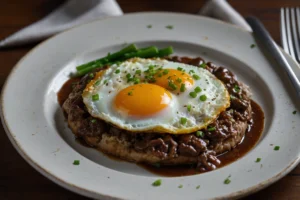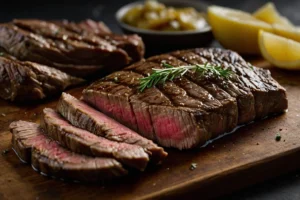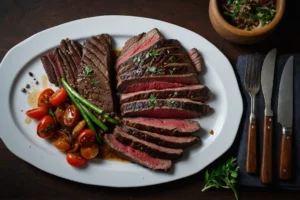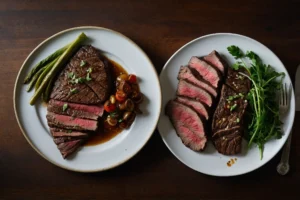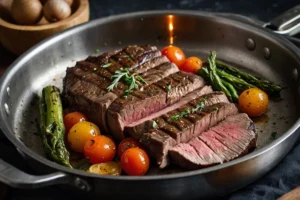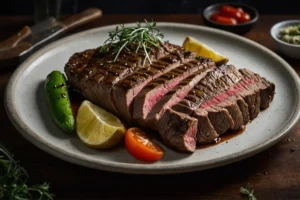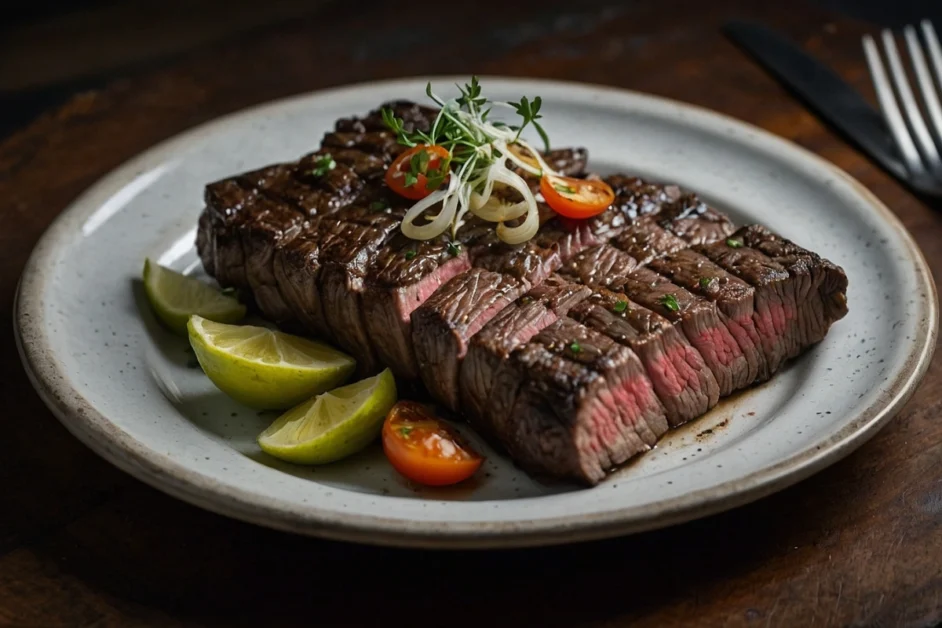Part 1: Understanding the Basics and Differences
1. Introduction to Skirt and Flank Steak
Skirt steak and flank steak are two of the most popular cuts in the U.S., known for their intense flavors and versatility in a wide variety of dishes. Whether you’re preparing fajitas, grilling for a backyard barbecue, or making stir-fry, these cuts often come up as go-to options. However, while they may look similar, they have distinct characteristics that set them apart.
Understanding the differences between skirt steak and flank steak can help home cooks and grill enthusiasts choose the right cut for the right recipe. Each steak has unique qualities, and knowing when and how to use each can make all the difference in your cooking.
For more grilling tips and techniques, you can refer to this guide on grilling steak to master the art of perfecting both cuts.
2. What is Skirt Steak?
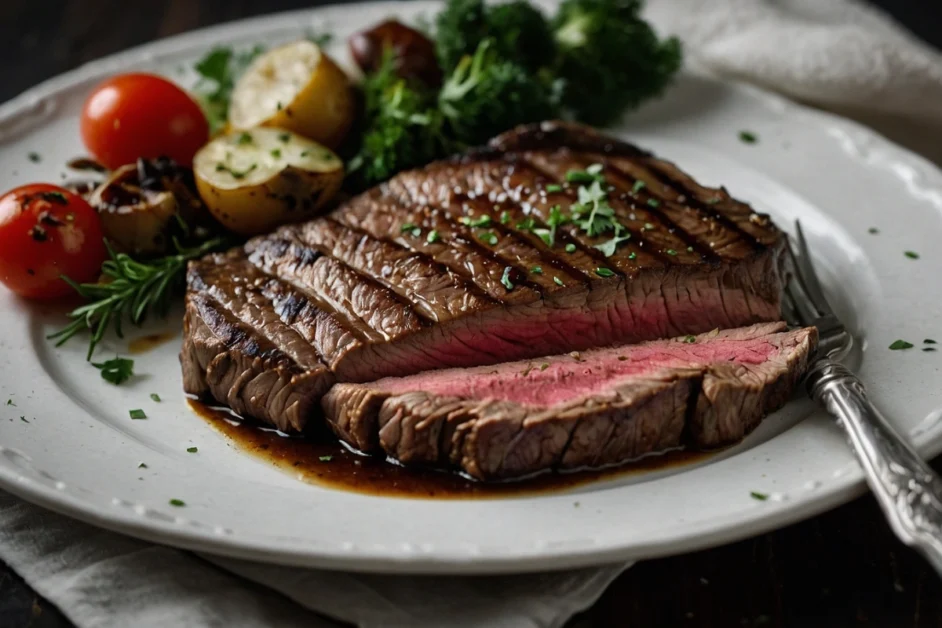
Skirt steak is a flavorful cut that comes from the diaphragm of the cow, located just below the ribcage. This steak is known for its fibrous texture, making it one of the chewiest cuts available. However, this texture contributes to its overall appeal because the muscle fibers in skirt steak, when properly cooked, deliver a tender yet beefy bite. There are two main types of skirt steak: inside skirt steak and outside skirt steak.
Inside Skirt Steak vs. Outside Skirt Steak
- Inside Skirt Steak: The inside skirt steak is typically thinner and more tender than its outside counterpart. It is easier to cook quickly over high heat due to its thinness.
- Outside Skirt Steak: This cut is a bit thicker, more flavorful, and slightly tougher, but when prepared properly, it can be just as delicious. It’s also often seen as more desirable in restaurants because of its richer flavor profile.
Skirt steak is beloved for its intense beef flavor, which comes from the higher fat content. This fat renders during cooking, giving the meat a succulent, juicy texture. Additionally, the higher fat content means skirt steak holds up well to marinades, as the fat helps absorb and distribute the flavors throughout the meat.
For a unique take on chicken dishes, check out this Easy Bibibop Copycat Chicken Recipe for a quick, flavorful meal.
Common Uses of Skirt Steak
- Fajitas: Skirt steak is the go-to cut for making traditional fajitas. Its rich flavor pairs beautifully with bold seasonings, peppers, and onions.
- Grilled Steak: Because it’s thin and cooks quickly, skirt steak is perfect for grilling. You can grill it over high heat for just a few minutes per side to get a perfectly charred exterior while keeping the inside juicy.
- Stir-Fries: Skirt steak’s thin slices work well in quick stir-fry recipes. When cooked rapidly at a high temperature, the meat stays tender, absorbing the flavors of any sauces or seasonings used.
When preparing skirt steak, it’s crucial to cut it thinly against the grain. This method of slicing breaks down the muscle fibers, making the meat more tender and easier to chew.
3. What is Flank Steak?
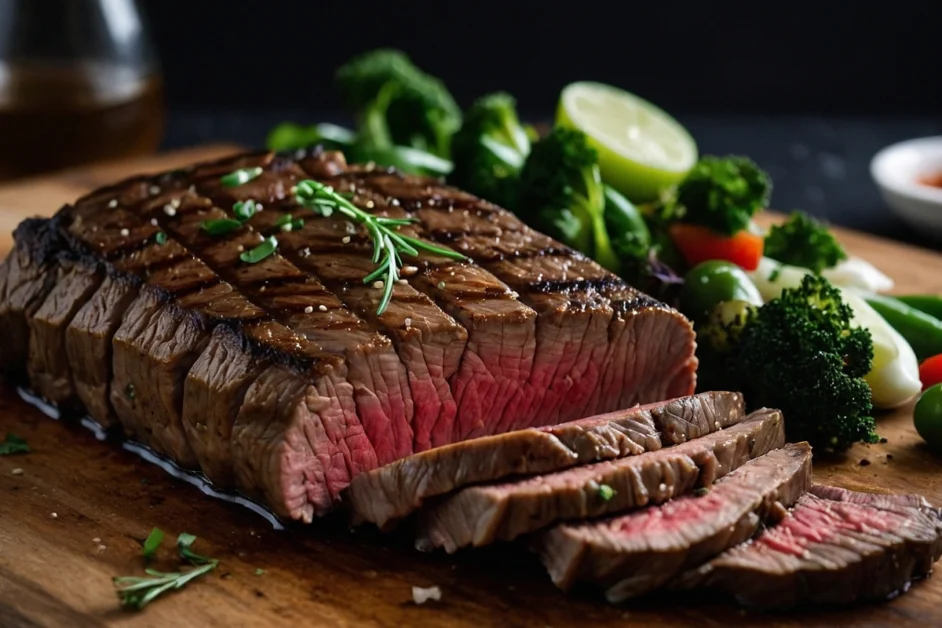
Flank steak is a long, flat cut of beef that comes from the lower abdominal muscles of the cow, located near the hind legs. Unlike skirt steak, flank steak is a leaner cut with significantly less fat, which contributes to its dense, firm texture. Despite being leaner, it still packs a lot of flavor and is popular in many cuisines worldwide.
Characteristics of Flank Steak
- Broader and Thicker: Compared to skirt steak, flank steak is thicker and broader, making it a better candidate for dishes that require slicing thinly across the grain.
- Lean with a Strong Beef Flavor: While it doesn’t have as much fat as skirt steak, flank steak still offers a rich beef flavor. It benefits greatly from marination, as the acids in the marinade help tenderize the fibers while adding flavor.
- Fibrous Texture: Because of its fibrous structure, flank steak can become tough if overcooked, so it’s essential to prepare it using fast cooking methods like grilling or broiling. Alternatively, slow cooking can also work well if you braise the steak.
Common Culinary Uses for Flank Steak
- Grilled Flank Steak: One of the most popular ways to prepare flank steak is by grilling. This method enhances its naturally rich flavor and creates a beautifully charred crust on the outside.
- Flank Steak Tacos: Flank steak is often used in tacos. Thinly sliced flank steak, marinated in citrus and herbs, works perfectly as a flavorful filling for tortillas, topped with salsa and fresh vegetables.
- Slow-Cooked Dishes: Because of its lean structure, flank steak also works well in slow-cooked dishes. Cooking it low and slow helps break down the fibers, resulting in tender, fall-apart meat that’s perfect for stews or braised dishes.
For both grilling and slow cooking, marinating flank steak is essential to ensure the meat stays moist and flavorful. The most common marinades feature acidic ingredients like lemon juice or vinegar, which help break down the tough fibers in the steak.
If you’re looking for more meal ideas, here’s a quick guide on what goes with chicken parmesan for perfect pairings.
4. Flavor Comparison: Skirt Steak vs. Flank Steak
When comparing the flavor of skirt steak and flank steak, both cuts offer rich, beefy tastes, but the higher fat content in skirt steak makes it more intense. Skirt steak is renowned for its bold, rich flavor, which comes from the fat that renders down during cooking. The fat not only adds flavor but also helps keep the meat moist, even when cooked quickly over high heat.
Flank steak, on the other hand, is leaner and slightly less flavorful than skirt steak. While it still delivers a strong beefy taste, the lower fat content means it requires a bit more care to avoid drying out during cooking. Marinating flank steak is a great way to inject additional flavor into the meat. With the right seasoning and cooking method, flank steak can match skirt steak’s flavor, though it may not be as bold.
How Cooking Affects Flavor
The cooking method used for each steak significantly affects its final flavor:
- Grilling: Grilling both cuts imparts a smoky, charred flavor. Skirt steak benefits from the high heat, which crisps up the exterior and leaves the interior juicy. Flank steak also works well on the grill, especially when marinated, as the high heat quickly sears the outside, locking in moisture.
- Pan-Searing: Pan-searing provides a beautiful crust on both steaks. Skirt steak, with its high fat content, will develop a crispy, flavorful exterior, while flank steak can still offer a robust flavor if seared quickly over high heat.
- Broiling: Broiling is ideal for both cuts, allowing them to cook quickly and evenly. The high heat of the broiler caramelizes the meat’s surface, enhancing its natural flavors.
Ultimately, skirt steak offers a more intense beefy flavor, while flank steak’s flavor is slightly subtler but still delicious. Both cuts perform well when paired with strong marinades or sauces that complement their natural taste.
Looking to explore more steak-based recipes? You might want to try this perfect flank steak recipe, ideal for grilling enthusiasts.
5. Texture and Tenderness Comparison
The texture of skirt steak is more fibrous and chewy compared to flank steak, which has a slightly more uniform and tender texture when cooked correctly. This difference in texture is due to the location of the muscles on the cow, as both cuts come from areas of the cow that are heavily worked, resulting in more fibrous muscle structures.
Skirt Steak’s Texture
Skirt steak’s muscle fibers run long and parallel, which gives it a distinctive chewiness. While this fibrous texture can make it tougher, it also means that skirt steak holds up well to high-heat cooking methods like grilling or broiling. When properly cooked and sliced thinly against the grain, the fibers break down, resulting in a steak that’s both tender and flavorful. However, overcooking skirt steak can make it excessively chewy, so it’s important to monitor cooking times carefully.
Flank Steak’s Texture
Flank steak, while still fibrous, is not as chewy as skirt steak. It has a denser structure, which can make it tough if overcooked, but it can be much more tender when cooked to medium-rare and sliced thinly against the grain. Like skirt steak, flank steak benefits from marinating, which helps tenderize the meat and infuses it with flavor.
Slicing Against the Grain
Both skirt steak and flank steak should always be sliced against the grain to ensure tenderness. Cutting against the grain means slicing perpendicular to the muscle fibers, which shortens the fibers and makes the steak easier to chew. This technique is especially important for these cuts because their natural texture can make them tough if not sliced properly.
The key to getting the best texture from either cut is to:
- Cook the meat quickly over high heat to avoid overcooking.
- Let the steak rest for a few minutes before slicing.
- Always slice against the grain to break down the muscle fibers.
6. Skirt Steak vs. Flank Steak: Cooking Methods
Both skirt steak and flank steak excel when cooked using high-heat methods, but there are important differences in how each cut should be prepared for optimal results.
Best Cooking Methods for Skirt Steak
Skirt steak is best suited to fast, high-heat cooking methods that quickly sear the outside while keeping the inside juicy. Due to its thinness, skirt steak cooks very quickly, so it’s important to monitor the cooking time closely to avoid overcooking. Some of the best methods include:
- Grilling: Grill skirt steak over direct high heat for about 2-3 minutes per side. This quick sear develops a charred crust while keeping the interior tender and flavorful.
- Stir-Frying: Skirt steak’s thinness makes it ideal for stir-frying. Slice the steak into thin strips and cook it quickly over high heat with vegetables and a flavorful sauce.
- Pan-Searing: If you don’t have access to a grill, pan-searing skirt steak in a cast-iron skillet is an excellent alternative. Heat the pan over high heat, add a little oil, and cook the steak for 2-3 minutes per side.
Best Cooking Methods for Flank Steak
Flank steak, being thicker than skirt steak, benefits from both fast and slow cooking methods. The best methods include:
- Grilling: Flank steak can be grilled over high heat for about 4-5 minutes per side for medium-rare doneness. The thicker cut requires a bit more time on the grill, but the result is a beautifully charred steak with a juicy interior.
- Broiling: Broiling flank steak is another great option, especially if you want to cook it indoors. Set the broiler to high and cook the steak for about 4-6 minutes per side, depending on thickness. The high heat creates a caramelized crust on the outside.
- Slow Cooking: Flank steak also works well in slow-cooked dishes. By braising or slow-cooking the steak, the fibers break down over time, resulting in tender, pull-apart meat that’s perfect for dishes like beef stew or tacos.
Why Marinating is Critical
Marinating is essential for both cuts to help tenderize the meat and add flavor. A good marinade typically contains acidic components like vinegar, citrus, or wine, which help break down the muscle fibers, making the meat more tender. Additionally, herbs, spices, and oils can infuse the steak with deep flavor.
Step-by-Step Guide to Marinating
- Choose Your Marinade: Select a marinade that contains an acidic component, such as lime juice, lemon juice, or vinegar. Add garlic, herbs, olive oil, and spices to complement the natural beefy flavors of the steak.
- Marinate the Steak: Place the steak in a resealable plastic bag or a shallow dish. Pour the marinade over the steak, ensuring that it is fully coated. Seal the bag or cover the dish and refrigerate for at least 30 minutes, but preferably 2-4 hours for maximum flavor.
- Cook and Slice: After marinating, cook the steak using one of the methods outlined above. Let the steak rest for a few minutes after cooking, then slice it against the grain for the most tender results.
Part 2: Nutritional Information, Recipes, and FAQs
7. Skirt Steak vs Flank Steak: Nutritional Comparison
When it comes to nutrition, there are some key differences between skirt steak and flank steak. Both cuts provide high levels of protein, essential vitamins, and minerals, but the differences in fat content impact the calorie count and overall nutritional profile.
Nutritional Breakdown of Skirt Steak
Skirt steak is higher in fat, which contributes to its rich flavor and juiciness. However, this also makes it more calorie-dense. A 3-ounce serving of cooked skirt steak contains approximately:
- Calories: 200-250
- Protein: 21 grams
- Fat: 12-16 grams
- Cholesterol: 70-80 milligrams
Because of its higher fat content, skirt steak is also higher in saturated fat compared to leaner cuts like flank steak. Despite this, it remains a good source of protein and provides important nutrients such as iron, zinc, and vitamin B12.
Nutritional Breakdown of Flank Steak
Flank steak, on the other hand, is a leaner cut, making it lower in fat and calories. A 3-ounce serving of cooked flank steak contains approximately:
- Calories: 160-180
- Protein: 23 grams
- Fat: 6-8 grams
- Cholesterol: 60-70 milligrams
While lower in fat, flank steak still provides a significant amount of protein and essential nutrients, making it a healthier option for those watching their fat intake. Like skirt steak, flank steak is rich in iron and B vitamins, supporting muscle health and energy production.
Health Benefits and Drawbacks
- Skirt Steak: The higher fat content in skirt steak makes it a more indulgent option. While the fat adds flavor and juiciness, it also means that skirt steak is higher in calories and saturated fat, which may not be ideal for those following a low-fat diet.
- Flank Steak: As a leaner cut, flank steak is a great choice for health-conscious individuals who still want to enjoy a flavorful steak. It’s lower in calories and fat but still provides plenty of protein and essential nutrients.
Both cuts offer great health benefits, particularly in terms of protein, iron, and zinc content, making them excellent choices for those looking to build or maintain muscle. However, those with dietary restrictions may prefer flank steak for its lower fat content.
8. Skirt Steak vs Flank Steak in Different Recipes
Both skirt steak and flank steak shine in a variety of recipes, offering flexibility for different cooking styles and flavor preferences.
Skirt Steak Recipes
- Skirt Steak Fajitas with Lime and Cilantro: Marinate skirt steak in a blend of lime juice, garlic, cilantro, and olive oil for at least 2 hours. Grill the steak over high heat for 2-3 minutes per side. Serve with sautéed peppers and onions on warm tortillas.
- Grilled Skirt Steak with Chimichurri: This dish pairs the bold flavor of grilled skirt steak with a vibrant chimichurri sauce made from parsley, garlic, red wine vinegar, and olive oil. Marinate the steak in olive oil, garlic, and a splash of red wine vinegar before grilling.
Flank Steak Recipes
- Flank Steak Tacos with Salsa: Marinate flank steak in a mixture of lime juice, garlic, cumin, and chili powder for at least 2 hours. Grill the steak over high heat, slice thinly against the grain, and serve in tortillas with fresh salsa, guacamole, and shredded lettuce.
- Broiled Flank Steak with Garlic Butter: Broil flank steak in the oven for 4-5 minutes per side, then top with a rich garlic butter sauce made with butter, garlic, and fresh herbs. Serve with roasted potatoes and a green salad for a complete meal.
Adapting Recipes for Skirt or Flank Steak
Both cuts can often be used interchangeably in recipes, though some adjustments may need to be made. For example:
- Cooking Time: Skirt steak is thinner and cooks more quickly, so reduce the cooking time when substituting it for flank steak in recipes.
- Marination: Both cuts benefit from marination, but flank steak, being leaner, might require a longer marination time to ensure tenderness.
Whether you’re cooking fajitas, tacos, or a grilled steak, both cuts can deliver delicious results with the right preparation.
9. How to Choose Between Skirt and Flank Steak for Your Dish
Deciding between skirt steak and flank steak depends on the dish you’re preparing, as well as your preferences for flavor and texture.
When to Choose Skirt Steak
Skirt steak is the best choice when you’re looking for a cut with a rich, intense flavor that can be cooked quickly over high heat. Its thin, fibrous texture is ideal for dishes that require fast cooking and thin slicing. Skirt steak works particularly well in:
- Fajitas: The intense beef flavor of skirt steak pairs perfectly with the bold spices and vegetables in fajitas.
- Grilled Dishes: Skirt steak grills beautifully, developing a flavorful char on the outside while staying juicy on the inside.
When to Choose Flank Steak
Flank steak is a great option when you want a leaner cut that is still full of flavor. Its thicker, broader structure makes it more versatile for slow-cooking methods as well as grilling. Flank steak is perfect for:
- Tacos: Flank steak’s lean structure makes it ideal for tacos, especially when marinated and thinly sliced against the grain.
- Slow-Cooked Dishes: Flank steak’s fibrous texture breaks down well in slow-cooked recipes like stews and braised dishes, resulting in tender, flavorful meat.
When deciding between the two, consider the cooking method, desired flavor intensity, and texture you want to achieve in your dish.
10. Skirt Steak vs Flank Steak: Price and Availability
While both skirt steak and flank steak are popular cuts, their prices and availability can vary depending on your location.
Price Comparison
- Skirt Steak: Due to its high-fat content and rich flavor, skirt steak is often more expensive than flank steak. It’s considered a premium cut, especially the outside skirt steak, which is prized for its flavor.
- Flank Steak: Flank steak is typically less expensive than skirt steak. It’s a great option for those looking for an affordable cut that still delivers on flavor and texture.
Availability
- Skirt Steak: Skirt steak can be harder to find in grocery stores because there is less skirt steak available per cow compared to other cuts. It may be easier to find at a butcher shop or specialty meat market.
- Flank Steak: Flank steak is more widely available and can be found in most grocery stores and butcher shops. Its popularity as a lean, versatile cut makes it a staple in many kitchens.
When choosing between the two, consider both your budget and the availability of each cut in your area. Flank steak is often the more accessible option, but skirt steak’s unique flavor can be worth the splurge for special occasions.
11. FAQs About Skirt and Flank Steak
Q: Can you substitute skirt steak for flank steak in recipes?
Yes, you can substitute skirt steak for flank steak in most recipes, but you’ll need to adjust the cooking time slightly. Since skirt steak is thinner, it cooks faster, so reduce the cooking time by a few minutes to avoid overcooking.
Q: Which steak is better for grilling?
Both skirt steak and flank steak are excellent for grilling. However, skirt steak may have an edge due to its high-fat content, which makes it more forgiving during high-heat cooking. Flank steak also grills well but requires close attention to avoid overcooking.
Q: How should I slice skirt and flank steak?
Always slice both skirt steak and flank steak against the grain. This technique shortens the muscle fibers, making the steak more tender and easier to chew.
Q: Can I marinate both skirt and flank steak?
Yes, both cuts benefit from marination. The acids in the marinade help break down the muscle fibers, making the meat more tender while adding flavor. Marinating for at least 2 hours is recommended for both cuts.
Q: Which cut is healthier?
Flank steak is the leaner of the two cuts, making it a better option for those watching their fat intake. However, both cuts are excellent sources of protein and essential nutrients like iron and B vitamins.
12. Conclusion
In summary, skirt steak and flank steak are both flavorful, versatile cuts with their own strengths. Skirt steak is richer and chewier, while flank steak is leaner and more tender when prepared correctly. Whether you’re grilling, stir-frying, or making tacos, understanding the differences between these cuts will help you choose the best steak for your meal.
Now that you know the distinctions, it’s time to try both cuts in different dishes and see which one works best for you!
